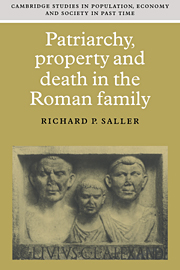Book contents
- Frontmatter
- Contents
- List of tables
- Preface
- Abbreviations
- 1 Introduction: approaches to the history of the Roman family
- Part I Roman life course and kinship: biology and culture
- Part II Roman family and culture: definitions and norms
- 4 Familia and domus: defining and representing the Roman family and household
- 5 Pietas and patria potestas: obligation and power in the Roman household
- 6 Whips and words: discipline and punishment in the Roman household
- Part III The devolution of property in the Roman family
- Bibliography
- Index
- Cambridge Studies in Population, Economy and Society in Past Time
4 - Familia and domus: defining and representing the Roman family and household
Published online by Cambridge University Press: 23 November 2009
- Frontmatter
- Contents
- List of tables
- Preface
- Abbreviations
- 1 Introduction: approaches to the history of the Roman family
- Part I Roman life course and kinship: biology and culture
- Part II Roman family and culture: definitions and norms
- 4 Familia and domus: defining and representing the Roman family and household
- 5 Pietas and patria potestas: obligation and power in the Roman household
- 6 Whips and words: discipline and punishment in the Roman household
- Part III The devolution of property in the Roman family
- Bibliography
- Index
- Cambridge Studies in Population, Economy and Society in Past Time
Summary
The subject of “family” may seem self-explanatory, but different cultures have defined the “family” and its boundaries in various fashions. This chapter seeks to elucidate the Roman understanding of family through a close examination of the basic Latin vocabulary and how this fundamental social unit was represented in certain important contexts. An analysis of the semantic ranges of familia and domus will enable us to explore some of the implications of Roman characterizations and representations of their families and households.
Understanding the Roman conception of the family is a delicate task, encountering the problematic relation between words and patterns of social behavior. There is no easy, one-to-one correspondence between vocabulary and social entities, and it is well to recognize from the outset the futility of attempting to define or to characterize the Roman family. Certain definitions were appropriate to, and clarified by, particular contexts. In other contexts the meaning of the word was left ambiguous, sometimes deliberately so. Moreover, the Romans represented their family bonds and household groups in visual art, ritual, and symbolic behavior in varying but related ways. Finally, if the Romans conceived of family and household variously according to context, each Roman had to construct his or her own family and household out of the kin and resources available, with the consequence that in the real world family and household came in innumerable shapes and sizes.
In view of the definitional messiness of familia and domus, and, even more, of the real living unit, it is pointless to endeavor to identify the form of the Roman family.
- Type
- Chapter
- Information
- Patriarchy, Property and Death in the Roman Family , pp. 74 - 101Publisher: Cambridge University PressPrint publication year: 1994
- 3
- Cited by



